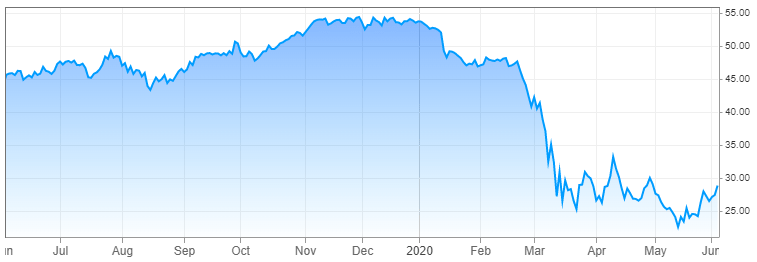Wells Fargo Stock Rises by 3%, as Bank Puts Limit on Auto Loans

During the Thursday trading session on the New York stock exchange, the Wells Fargo & Company (WFC) shares have gained 3%. The stock previously closed at $28.83, but today the price has reached $29.70.
The move came after the came after, the bank made some moves to reduce its lending risks. The firm recently announced that it would no longer accept applications for new home equity lines of credit. In addition, today the bank stated that it will stop making auto loans through the majority of the car dealerships. The representatives of the company have no specified for how long those measures will be in effect. So potentially, this policy can last for several months.
Considering the market reaction, it seems that investors like the implementation of those measures. In times of economic downturn, reducing risks always seems to be a very reasonable and prudent move. By the end of 2019, the unemployment rate in the United States was at 3.6%, which was historically low level, indeed many analysts warned that this ‘new normal’ might not persist for a very long time. Those predictions were eventually proven to be accurate.
After the outbreak of the COVID-19 pandemic, the number of job losses skyrocketed. As a result, by April 2020, the unemployment rate in the US has reached a staggering 14.7%. For many developing countries this high degree of joblessness is very common. However, the United States has not seen such a high degree of unemployment since the great depression. Even during economically challenging times of World War 2, many people joined the military or alternatively found employment in industrial production, so even by that time this was not such a great problem.
Now obviously, as more businesses open up the actual unemployment rate might start to moderate, so it might slowly return to 12% or 10% in the coming months. However, one thing is clear: the jobless rate is not going to return back to 2019 levels any time soon.
Well’s Fargo’s Risk Reduction Strategy
As we can see from the economic figures above, the United States is experiencing very challenging economic times. Consequently, it makes a lot of sense for the US banks to take concrete steps to reduce their risk exposure. However, putting some direct limits on consumer loans or mortgages can be very damaging not only for consumers but for financial institutions themselves. Therefore Wells Fargo’s management essentially decided to take smaller, yet decisive steps to address those concerns.
According to the Motley Fool, by the end of 2019, the default rate on Auto loans stood at 4.9%. Now, considering the massive expansion in the number of unemployed people, obviously, it not unreasonable to expect that this rate can double or even triple. This means that the default rate on Auto loans can surpass 10% or even reach 15%.
So here essentially Wells Fargo management has decided to take pre-emptive steps to avoid suffering those heavy losses on those kinds of loans. In the past, the US government with the obvious exception of the Lehman Brothers case did step in to save the struggling banks through its Troubled Asset Relieve Program (TARP). However, there is no such thing as accepting government money with no strings attached. Such bailouts always come with restrictions and other specific conditions. So this is why Wells Fargo’s management tries to avoid the repeat of the scenario of 2008.
Wells Fargo Stock Price Performance and Current Valuations

source: cnbc.com
As we can see from this chart, the Wells Fargo shares made some gains during the second half of 2019, rising from $45 to $54 by the end of the year. However, the slide of the WFC price has begun even before the March 2020 stock market crash. The downward move has accelerated during the second half of February and by May 2020, the stock was trading close to $25 level. Recently, Wells Fargo’s shares regained some ground and now trade just below $30 mark. However, even at current rates, the stock needs to gain more than 60% in order to return back to January levels.
According to CNBC, the current earnings per share (EPS) indicator of the bank stands at $2.83. This means that the price to earnings (P/E) ratio of the firm is around 10.5. This suggests that the Wells Fargo shares might be undervalued and do have decent growth potential if the firm can withstand current economic challenges. The beta of the stock is at 1.17, so it is approximately 17% more volatile than the Dow Jones Industrial Average.
Will Wells Fargo Cut Its Dividend?
Recently in the financial press, we see many articles, suggesting that indeed Wells Fargo is a ‘dividend cut candidate’, that the bank is very likely to reduce payouts to its shareholders. This assumption is based on the fact that the current dividend yield of the stock is close to 7%, which is much higher than many of its peers. Also, the recent outbreak of the COVID-19 pandemic had a negative effect on Bank’s earnings and left it with less money to work with.
Obviously, the reduction of those payouts is a distinct possibility. After all, no company is under a legal obligation to always deliver payments to its owners. However, the question is how likely is that to happen?
Well, we can always check some data to come up with educated guesses. According to the latest data, provided by stocknews.com, the payout ratio of the firm is just below 65%. This means that this indicator is not yet dangerously high and the bank still has enough margin of safety to keep up with those payments. Also, the company has a very solid track record of returning money to its shareholders, which is one of the reasons why Warren Buffet’s firm owns a significant portion of the bank.
Obviously, this does not necessarily imply, that we should rule out any Wells Fargo’s management might decide to go ahead with a dividend cut. So far it seems that the company will not be forced to do this. However, it is also possible for the board to take this step as a precautionary measure, to shore up it’s financial standing.


























Comments (0 comment(s))